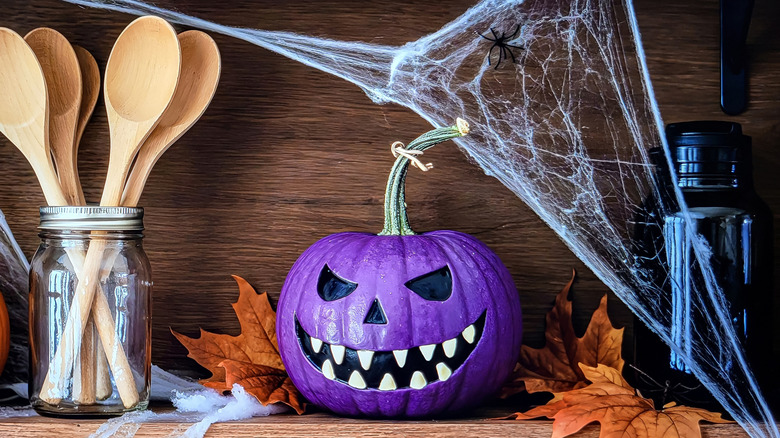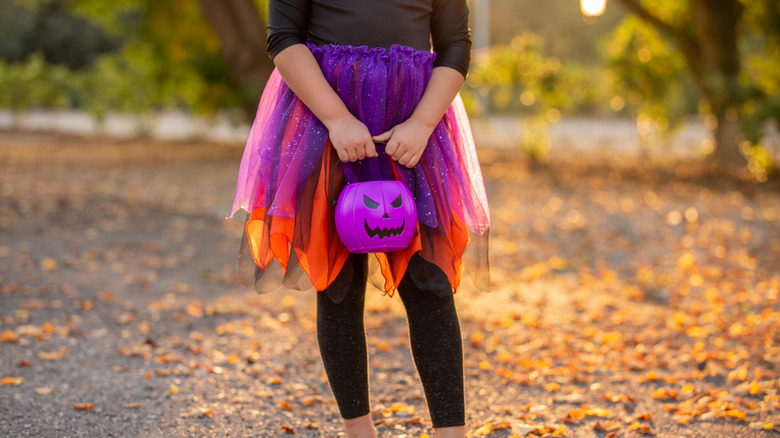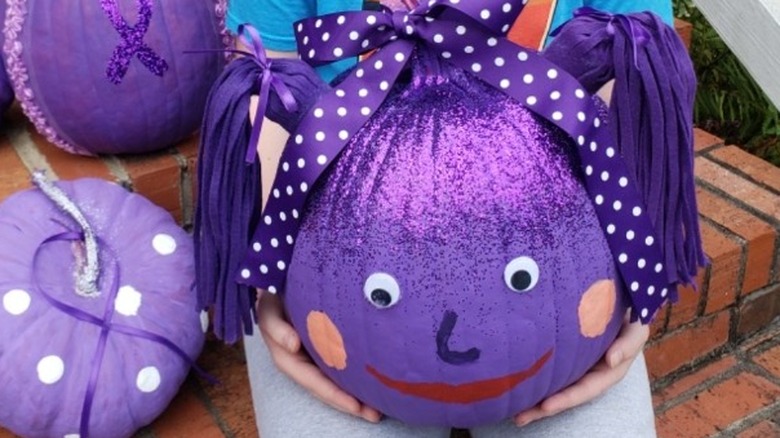What It Means To Put A Purple Pumpkin On Your Porch
Pumpkins and jack-o'-lanterns — time-honored traditions for outdoor Halloween décor — usually have a familiar orange hue. But year after year, more of these decorative gourds are taking on out-of-the-ordinary colors to raise awareness and foster conversations about various health concerns. For example, yellow pumpkins on a porch represent autism, and teal ones alert others about food allergies. Purple is another color you may see on porches around Halloween, and it's used to encourage epilepsy awareness, raise funds for various epilepsy foundations, and make the holiday more inclusive for kids who have the condition. The reason pumpkins are painted purple to represent epilepsy is that lavender (a shade of purple) is associated with the disorder globally.
If you or someone in your family has epilepsy — a neurological disorder creating flows of electrical activity in the brain that trigger seizures — placing a purple pumpkin on the porch alerts others who may want to learn more about your experience. Even if you're not affected by the condition, you can still paint a pumpkin purple to raise awareness about it. The custom of using purple pumpkins came about in 2012 as part of the Purple Pumpkin Project with the Epilepsy Foundation, which was announced on the foundation's Facebook page.
The first person to paint a pumpkin purple was Ron Lamontagne of Connecticut, who wanted to make others aware of the challenges his son faced as a youngster with epilepsy. After he shared his purple pumpkin, photos of other similarly painted pumpkins placed on porches in all corners of the United States soon appeared on the page, with many being decorated by children or their families.
How the Purple Pumpkin Project makes Halloween more inclusive
Epilepsy awareness was at the heart of Ron Lamontagne's initiative. He wanted passersby, neighbors, and folks out trick-or-treating with their kids to ask — "Why is your pumpkin purple?" But apart from spreading knowledge about the condition, these conversations had another beneficial effect — they eased the stigma around epilepsy. Thanks to the Purple Pumpkin Project, some children affected by epilepsy found the courage to open up about their condition and saw their quality of life improve as a result. The project has raised funds for various epilepsy foundations as well.
The Purple Pumpkin Project also aims to help young trick-or-treaters with epilepsy have a safer and more inclusive experience on Halloween. If you see a child carrying a purple bucket, there's a good chance that they have epilepsy and are using the color to signal people handing out treats. There are a few ways you can accommodate such a child if one comes to your door. For one, be ready if they experience a seizure on your porch. At the same time, make it easy for them to reach for the treats. Seizures aren't the only symptom of epilepsy; it may also cause anxiety and irritability, and you shouldn't aggravate these conditions by making the experience difficult for the child. It's also best not to scare them, since stress is a seizure trigger for some individuals.
Likewise, since some epileptic children are on a ketogenic diet, it's better not to give out regular candy to trick-or-treaters armed with purple buckets. Instead, stock up on keto-friendly snacks, which are often sweet and appetizing, not to mention healthier than traditional, sugar-laden Halloween sweets.
How to create a pumpkin purple for your porch
If you're looking to decorate your porch with a purple pumpkin, the easiest route to take is to paint one yourself. Better yet, visit a local pumpkin patch with a child in your life, choose a pumpkin, and then paint it together as a fun craft project. All you'll need beyond your gourd of choice is an inexpensive foam paintbrush, suitable paint for decorating pumpkins, and either a spray or brush-on acrylic sealer.
Before you start this painting project, put down a drop cloth or a newspaper to protect against messes, then prep the pumpkin by making sure it's clean and dry. Apply a base coat of sealer to the entire pumpkin and allow it to dry. Then, you're ready to paint. Working with one half of the pumpkin at a time and letting it dry is a neater alternative to painting the whole thing right away. If needed, add additional coats of purple paint until you get the desired color saturation. After the pumpkin dries, apply a coat of sealer over the paint. You can deem the project complete or add some cute embellishments before decorating your home with the pumpkins.


